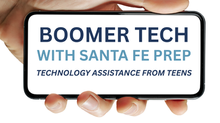Notes from the Village to Village Conference
- Michelle Rothwell

- Oct 27, 2016
- 4 min read
Michelle and Sheila Doran-Benyon attended the National Village to Village Conference, Oct. 16-19 in Columbus, Ohio. Watch for a pop-up coffee in the coming weeks to hear more about the convention from them.
What did I learn?
It’s very exciting to be a part of this movement
There are some extraordinary people involved in Villages across the country
The national board seems a bit out of touch?There was no discussion about how to influence policy at a local, state or national level, and there was a huge gap in having breakout sessions around Villages that could share unique things they are doing that could help other villages
There was acknowledgement that current Villages are built around more middle to upper income residents and that there is a big opportunity to improve the diversity of Villages outreach
We have an opportunity for Santa Fe to become an Age Friendly Community
Instead of Aging in Place, villages are starting to change the verbiage to Aging in Your Community
Airbnb – their largest offerings are coming from residents Age 50+
SilverNest – new company that matches interested renters with seniors who have a room for rent
February 13th – National Villages Day with Atul Gawande Webinar
The National Volunteer Transportation Center is going to offer an on-line volunteer driving course for a nominal fee
YELP does not have any way to filter businesses that offer benefits and services to people over 40
Cyber liability – NEW – a nice to have for insurance policies that covers volunteers dropping devices, protection of sensitive and private information
From Bill Thomas:
The ultimate thing in life is to rely on others and have others rely on you
From Ashton Applewhite:
The odds of getting Alzheimer’s is dropping
4% of Americans are in nursing homes (down from 5% the previous year)
As a society, we are petrified of aging
From the UC Berkley research update:
They have done four national studies looking at growth and sustainability
Most recent study looked at how villages have changed from 2012 to 2016; stats and findings:
Surveyed 115 villages with median membership of 115
36% urban, 35% suburban and 13% rural
10% have existed more than 9 years
26% of the villages surveyed began in 2014/2015
80% of villages have paid staff (1.8 per village)
Average # of volunteers per village – 60
Members make up 85% of village boards
Average membership fee - $410 for individuals, $601 for household
47% offer tiered pricing
72% offer discounted membership based on need
Average annual budget - $103,000
42% have endowments
Less than 10% of membership is low income and minority
Outreach effort focus – 47% lower income, 30% younger, 25% ethnic, 13% LGBT
Villages have increased confidence that chapter will sustain
Villages are more urban than rural
There is a slight increase on average in village membership
Villages are more likely to have reserve funds – support from government, foundation contributions and formal collaborations with other organizations
Very little change in budget size, staffing levels, and % of budget from dues (average is 50%)
Villages are less likely to offer 24/7 care, personal care, care coordination and services for non-members
96% of villages part of national V to V network
Income level – 74% $50K+
Age – 42% 72 and older
96% white, 72% female, 42% live alone
Need more collaboration among villages
It is difficult to converse about villages as a concept – people have difficulty grasping it
The National Board has been great at starting villages; now the Board needs to help villages mature and sustain
We need to invigorate the village movements
Service Year Alliance Initiative – helping younger adults contribute to society
Villages Service Year – connect younger adults (18-25 age group) to older adults and help them:
Enter the workforce
Deal with debt
Learn to be effective as part of a workforce
Launching in New York next month
Will mean a more elevated stage for Villages
Pilot program development – will launch in the Spring of 2017; March - ID pilot communications and pilot cities; Fall – launch to all villages
Pilot program elements will include stipend, student loan forgiveness and housing benefits
We want to be a pilot city!
Here are some cool things that cities/villages are doing:
Walking School Bus – in neighborhoods where there is no bus for school kids, seniors walk the kids to and from school (they work with PTA’s to identify parents who may want this help for their kids)
Accessory Homes – someone with a large garage or extra rooms lease the space out for extra income
There is a much larger focus on involving millennials and high school/college students in village activities; they can get school credits but it’s also increasing their awareness of aging issues
Hazardous waste and recycling pickup
Involving girl and boy scout troop members as volunteers for special projects
Home Downeast in Maine has one of the highest elder poverty rates in the nation – their village model partners with a local 25-bed hospital
Joel Shapira/Seth Steinberg presentation on problem solving (these guys talked this in the context of HONOR, a company that matches home health agencies with people who need home health care)
Fail fast – experiment more instead of spending too much time in planning and product development – be disruptive!
Work on your own problem – ID your team
Narrow scope to something truly addressable
Look at solutions available today
Look at human solution first, technology solution second












































Comments